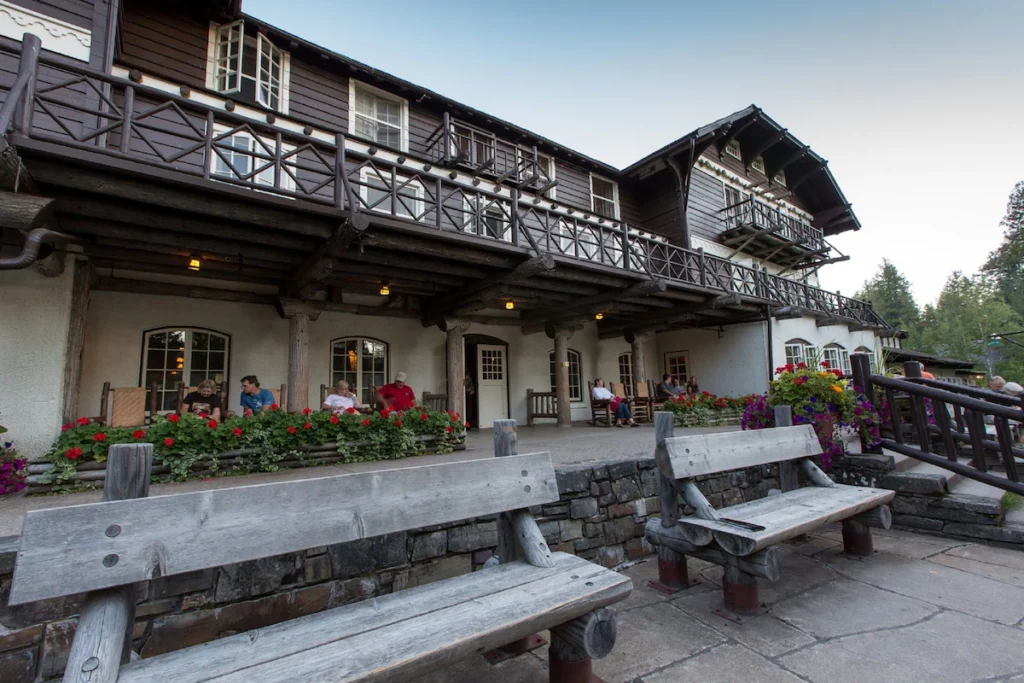|
Getting your Trinity Audio player ready...
|
The stunningly gorgeous Glacier National Park can be admired from the dizzying heights of Going-to-the-Sun Road, a remarkable feat of engineering that winds along the cliffside, offering jaw-dropping views of the wilderness and a reminder of how powerful nature can be.
Established in 1910
Overview
Situated on the border of Canada and the United States, Glacier National Park is a stunning natural wonder that covers over 1 million acres. It is also connected to Waterton Lakes National Park in Canada, forming the Waterton-Glacier International Peace Park. Within its borders lie two mountain ranges, more than 130 named lakes, over 1,000 different plant species, and numerous animal species. This magnificent and unspoiled ecosystem is the focal point of the “Crown of the Continent Ecosystem,” a vast region of protected land spanning 16,000 square miles.
This iconic park was founded in 1910 and boasts two subranges of the Rocky Mountains, numerous glaciers, and over 700 shimmering lakes. The sprawling terrain is also home to a diverse array of wildlife and plant species. This rugged and scenic landscape spans across much of northwestern Montana and even reaches up to the border between Canada and the United States. Thanks to its early establishment as a national park, the area has been able to maintain its natural beauty while also protecting its native inhabitants.
The area that now comprises Glacier National Park was initially inhabited by Native American tribes. When European explorers arrived, the Blackfeet in the east and the Flathead in the west were the dominant groups. However, under pressure from the government, the Blackfeet ceded their mountainous lands in 1895, which eventually became part of the park. In 1910, after its official establishment on May 11th, several hotels and chalets were built by the Great Northern Railway company. These structures have since been recognized as National Historic Landmarks, with a total of 350 sites being listed on the National Register of Historic Places. The Going-to-the-Sun Road was completed in 1932 and is now designated as a National Historic Civil Engineering Landmark, making it easier for motorists to access the heart of the park.
170 million years ago, Glacier National Park’s mountain ranges began to take shape as older rocks were pushed eastward over newer rock layers. These sedimentary formations, known as the Lewis Overthrust, are known for preserving some of the earliest evidence of life on Earth. The current formations and locations of the Lewis and Livingston mountain ranges, as well as the size and placement of lakes, are all results of massive glacial activity that occurred in the past. The evidence of this can be seen in the U-shaped valleys and moraines that created natural dams and formed lakes. In the mid-19th century, there were around 150 glaciers with an area of at least 25 acres within the park due to the Little Ice Age. However, by 2010, only 25 active glaciers remained. Scientists predict that if current climate patterns continue, all active glaciers may disappear by 2030.
An Essential Guide to the Melting Glaciers in Glacier National Park, Montana
Glacier National Park has retained almost all of its original plant and animal species from before Europeans arrived. A wide variety of large mammals, including American black bears, grizzly bears, bighorn sheep, elk, moose, mountain lions, and mountain goats can be found within the park. Other predators such as gray wolves, wolverines, and Canadian lynx also call the park home. Additionally, numerous bird species, over a dozen fish species, and several reptiles and amphibians have been identified. The park is also home to thousands of species of butterflies, pollinating insects, and other invertebrates.
Within the park, one can find a diverse range of ecosystems, including prairies and tundra. Towards the southwest portion of the park, eastern forests of western redcedar and hemlock can be observed. The park is no stranger to forest fires, with an annual occurrence since its inception except for one year in 1964. In fact, there were 64 recorded fires in just one year – 1936. The most recent major fire was in 2003 when six fires burned over 136,000 acres, accounting for more than 13% of the total park area.
Waterton Lakes National Park in Canada and Glacier National Park in the United States share a border, making them the Waterton-Glacier International Peace Park, the world’s first designated International Peace Park in 1932. Both parks were also recognized by the United Nations as Biosphere Reserves in 1976 and World Heritage Sites in 1995. In April 2017, the joint park gained provisional Gold Tier status as Waterton-Glacier International Dark Sky Park through the International Dark Sky Association, becoming the first transboundary dark sky park.
Highlights:
- Experience the stunning vistas and traverse the continental divide at Logan Pass while driving along Glacier National Park’s famous Going-to-the-Sun Road.
- Hike on the renowned Highline Trail, which boasts a thrilling cliffside trek along the Garden Wall. Alternatively, keep an eye out for majestic big-horn sheep while hiking towards Hidden Lake.
- Experience the beauty of a sunset cruise on the picturesque St Marys Lake.
- Take in breathtaking views of glaciers and icefields as you hike to Iceberg Lake, where adventurous individuals can take a dip amongst the floating chunks of ice.
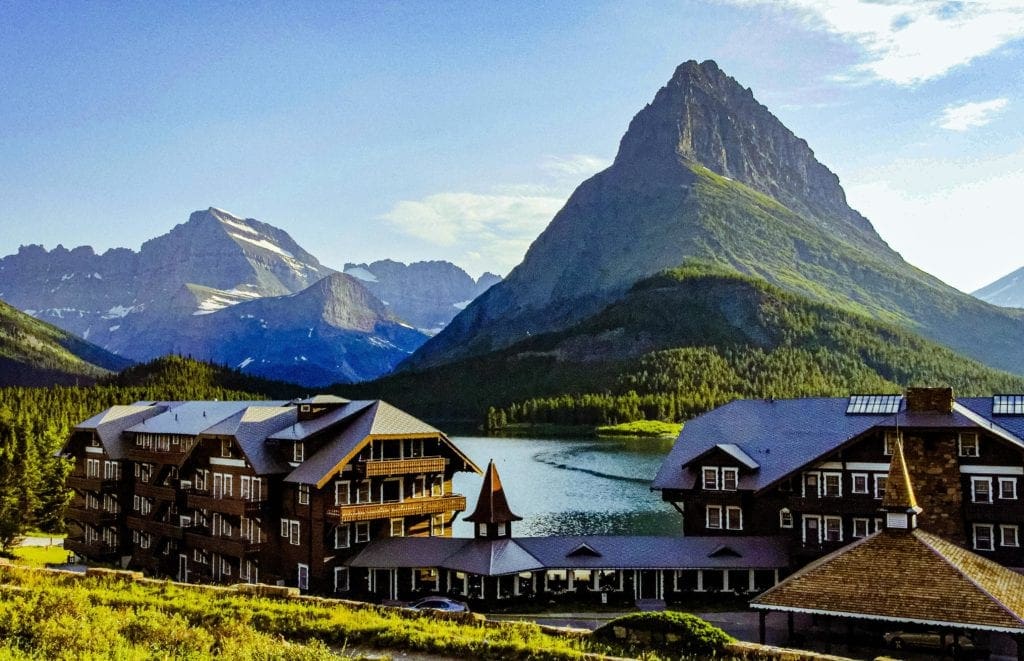
View of the Many Glacier Hotel, located in the northeastern area of Glacier National Park at Swiftcurrent Lake.
Luxury Campervan Rentals for Iconic Road Trips: Moterra Campervans is your gateway to exploring America’s most beautiful landscapes with complete comfort and capability. Rent a luxury Mercedes Sprinter van fully loaded for road trips and vacations, with curated itineraries for national parks and other breathtaking public lands. Rental Hub located in Whitefish, Montana.
Book Now!
Table of Contents:
Article Navigation: Click on any of the listed items in the table of contents below to jump to that section of the article. Similarly, clicking on any large, white section header will jump you back to the Table of Contents.
- Overview
- History
- Geology & Geography
- Flora & Fauna
- Places To Stay
- Main Attractions
- Nearby Cities
- Conclusion
History
The land that now encompasses Glacier National Park was home to Native American tribes for millennia before it became a park. Human presence in the region is estimated to date back over 10,000 years. The Cheyenne, Flathead (Salish), and Kootenai peoples inhabited the central and western sections of the park, while the Blackfeet tribe occupied the eastern slopes where their reservation now stands.
During the 1850s, Lewis and Clark ventured close to the mountains that now make up Glacier National Park. However, it wasn’t until later expeditions that white settlers actually explored the land.
George Bird Grinnell, an explorer of the 1880s, was captivated by the rugged peaks he encountered during his travels. Determined to protect this land, he made it his mission to establish a national park here. A young editor at Forest and Stream when he first visited in 1885, Grinnell was amazed by the Glacier’s untouched wilderness. He used the magazine’s influence to advocate for Glacier’s status as a national park. As a founder of the Audubon Society and a close friend of President Theodore Roosevelt, he earned the title “father of American conservation.” Grinnell also authored numerous books about the American West, including many on the Plains Indians. Today, one of Glacier’s famous glaciers is named after him – the Grinnell Glacier.
The establishment of the Great Northern Railway in 1891 helped to bring more visitors to the area, as it ran along the southern border of the future park. As word spread about the stunning landscape, efforts to attract tourists along the railway increased.
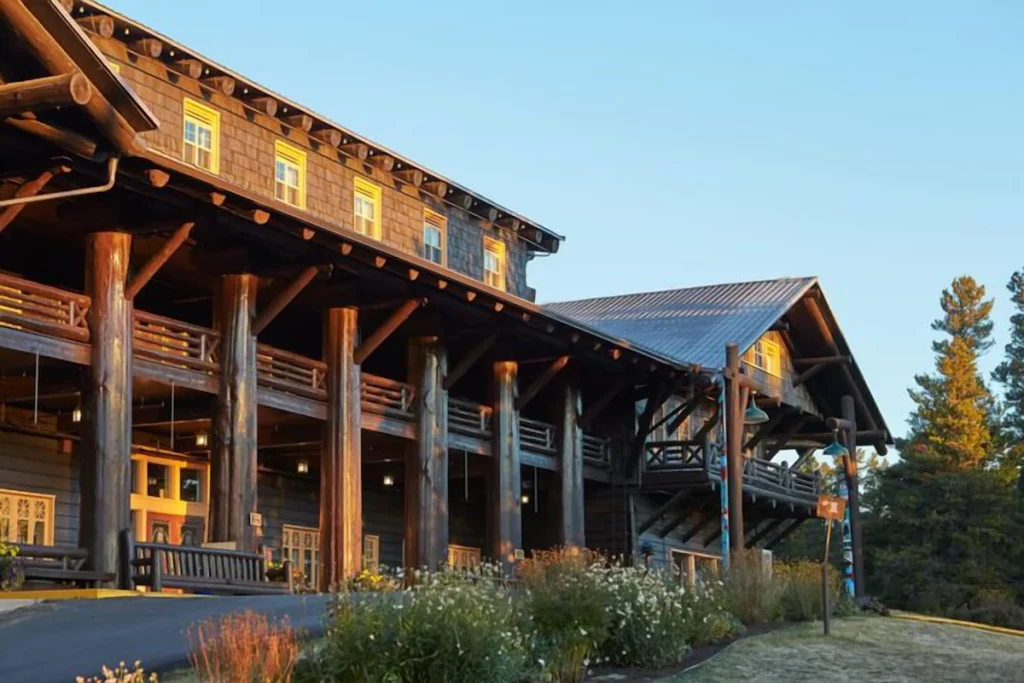
Glacier Park Lodge in East Glacier, Montana was built in 1913 by the Glacier Park Company, part of the Great Northern Railway. Photo: Glacier Park Lodge.
In 1897, the land was declared a forest preserve before it became a national park. Only 13 years later, President Taft approved the bill to transform the forest into what is now known as Glacier National Park.
In order to attract visitors to the sparsely populated area, several chalets were built within the first few years of establishing the park. The Lewis Glacier Hotel, later renamed Lake McDonald Lodge, and the Going-to-the-Sun Road construction were key factors in drawing more people to the region. This 53-mile road is now a recognized National Historic Civil Engineering Landmark. In celebration of the park’s centennial anniversary, the iconic road underwent its largest repair project in 2010.
Geology & Geography
During the last ice age, massive glaciers carved out the rugged peaks that make up this park. However, due to natural earth cycles and the effects of climate change, almost all of these glaciers have vanished. The park’s landscape is defined by wide valleys and steep peaks, evidence of the powerful influence of glaciers. In the 1950s, researchers identified over 150 glaciers throughout the park. But as of 2010, only 37 remain, and they are expected to continue shrinking or disappearing completely by 2030. This rapid melting also poses a threat to the biodiversity of both plant and animal species within the park.
The northern part of Glacier National Park borders the Waterton Lakes National Park in Alberta, Canada. It also shares a border with British Columbia’s Flathead Provincial Park and Akamina-Kishinena Provincial Park. The park is home to an estimated 700 lakes, but only 131 have been given official names. The longest and largest lake in the park is Lake McDonald, situated in the western region and covering over 6,900 acres at a length of 10 miles.
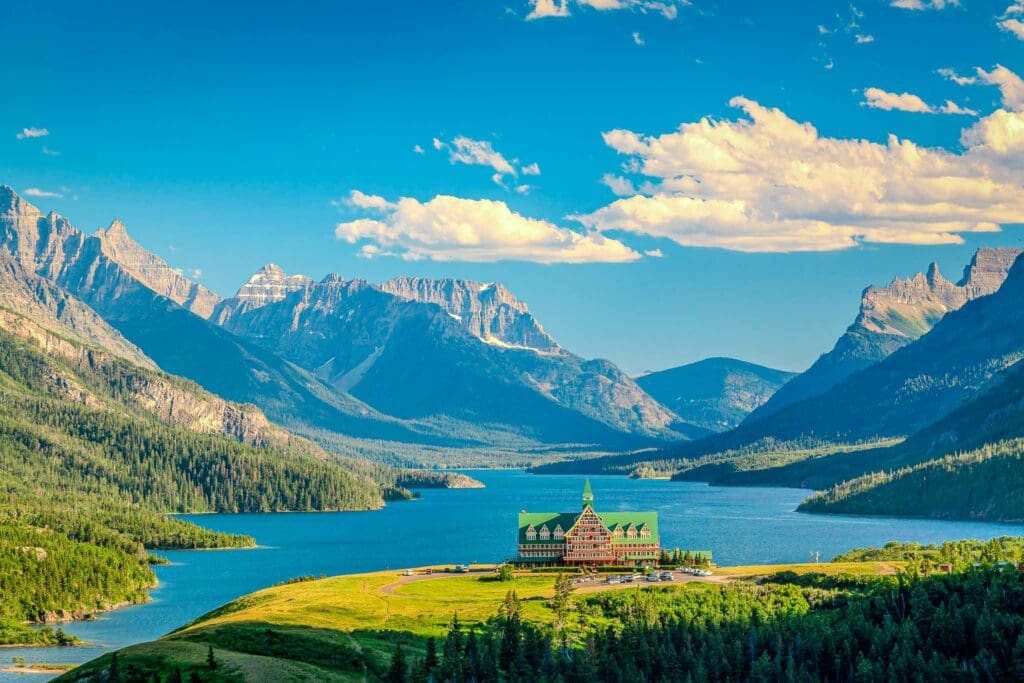
View of the Prince of Wales Hotel in Waterton Lakes National Park, Alberta, Canada, which shares a border with Glacier NP.
The Rocky Mountains stretch from north to south within the park, reaching into both Canadian and American territories. These mountains were created over 170 million years ago through an overthrust, a geological process in which older rock is pushed above younger rock. Evidence of this can be found throughout the peaks of the park.
Flora & Fauna
Due to its vast expanse and long history, Glacier National Park has earned the nickname “Crown of the Continent Ecosystem”. More than a hundred years of preservation in this area has resulted in the flourishing of almost all indigenous species.
Among the 1,100 plant species that inhabit the park, the majority of the terrain is covered in coniferous forest. These expansive regions are dominated by subalpine fir, Engelmann spruce, and Douglas fir trees. As you descend into lower elevations, aspen and cottonwood trees become more common near water sources. The western forests of the park are notably dense due to their exposure to higher levels of rainfall compared to the eastern slopes.
As you ascend to higher elevations, the dense forests of coniferous trees gradually fade into a landscape of untamed grasses and vibrant wildflowers. Some of the more common species found within the park are Indian paintbrush, fireweed, glacier lily, monkey flower, beargrass, and balsamroot.

Beautiful views of Indian Paintbrush over Glacier National Park, Montana.
Glacier National Park’s official symbol is the Rocky Mountain goat, and they are well adapted to thrive in its rugged landscape. With their sticky and flexible hoof pads, these goats can easily navigate near-vertical cliffs and uneven boulders. Their dense double-layered wool coat protects them from harsh winds and extreme cold, with temperatures that can drop as low as -50 degrees Fahrenheit (-45 degrees Celsius) in winter.

Mountain Goats at Hidden Lake.
It’s not unusual for guests to see grizzly bears chomping away in the berry bushes, sometimes surprisingly near to groups of hikers. These majestic animals are a vulnerable species in the United States and at risk of extinction in Canada, yet they thrive in Glacier National Park. It is estimated that around 300 grizzlies dwell within the park’s borders. When standing on their hind legs, these creatures can reach over 6 feet (1.8 meters) tall.
It’s not surprising that rangers and park signs constantly stress the importance of bear safety, as it’s for both the bears’ well-being and the travelers’. Typically, grizzly bears stick to themselves and consume a vegetarian diet consisting of berries, seeds, roots, and grasses. On occasion, they may also eat trout, carrion, or even an elk calf. During winter when food is scarce, the bears will migrate to higher elevations to hibernate.
They try to avoid humans whenever possible, but if you’re hiking in bear country, it’s important to make enough noise so that you don’t startle a bear. Park rangers suggest going on hikes with at least three or four people. Some of the most popular trails in Glacier National Park pass through prime bear territory, so it’s crucial to follow safety precautions and remember that you are walking through their home.
In Glacier National Park, black bears are a common sight and can often be mistaken for grizzly bears. These bears vary in color from blonde to dark brown, with the black bear being on the smaller side and lacking the distinctive shoulder hump of a grizzly.

Grizzly bear entering a stream in Glacier National Park.
Places To Stay
Whitefish, Montana Campervan Rentals:
Moterra Travel strives to offer van rentals that provide customers with the tools and resources to fully embrace their journeys in comfort and without limitations. Their state-of-the-art campervans come equipped with all the necessities for a truly unforgettable vacation, along with the unparalleled assistance of their dedicated and meticulous team.
Immerse yourself in the untouched wilderness of Glacier National Park and beyond by renting a rugged campervan near Kalispell, Montana and its bustling international airport. Moterra’s Whitefish campervan hub puts you just a mere half hour away from the park’s entrance, and under an hour from the breathtaking Flathead Valley. But why stop there? Cross the border and embark on an epic road trip to Waterton Lakes National Park, Banff & Lake Louise, Jasper National Park, and countless other hidden treasures nestled in the untamed Canadian Rockies.
Drive through the mountains of Glacier National Park with a powerful Mercedes Sprinter van. The daunting peaks give way to emerald lakes and untouched forests. Begin your true journey in a fully stocked, four-wheel-drive Moterra campervan rental near the airport. Experience the Crown of the Continent from mid June to September in a rented campervan.
Glamping at Under Canvas – Glacier:
Located just seven miles from the west entrance to Glacier National Park, Under Canvas Glacier offers travelers a one-of-kind, upscale, outdoor experience in Montana’s “Big Sky Country.” Recognized as a ‘Top 20 Resort in the U.S. – Pacific Northwest & West’ by Condé Nast Traveler, Under Canvas Glacier is designed in close connection to the surrounding wilderness, offering easy access to the park’s 700 miles of trails to breathtaking alpine lakes, rugged snow-capped peaks, and wildflower-covered meadows.
Offering tent types to accommodate any group size, ranging from couples to large families and everything in-between, our upscale canvas tents provide the perfect respite surrounded by the beauty of nature. Under Canvas’ traditional tent types include the Suites, Deluxes, Stargazers, and Safaris. Tents accommodating up to two children are also available with traditional tent types. Select locations also feature Two-Tent Suites for larger families and groups. Explore our tent types below and find the one that best accommodates your needs.
Book Your Tent Now at Expedia!
Hipcamp Near Glacier:
Hipcamp.com is a revolutionary website that unlocks a world of adventurous possibilities for those seeking to escape the confines of urban walls. With untethered access to all public parks and private lands.
Hipcampers can discover and book unique outdoor stays ranging from traditional tent camping to luxurious treehouses and glamping options. More than just a booking platform, Hipcamp is on a mission to inspire people to embrace nature and support landowners who are dedicated to preserving their land from development. It’s time to break free from the mundane and embrace the wild unknown with Hipcamp!
There are many options for hipcamping near Glacier National Park, depending on your preferences and budget. Here are a couple of the best places near Glacier National Park:
- Glacier HipCamp: This is a 37-acre property that offers a unique eco-camping experience in contrast to the crowded campground/RV park. It has forested trails, a large pond, a creek, and frequent wildlife. All sites have a campfire ring and picnic table, but no hookups. It is only 6 miles away from the entrance to Glacier National Park and close to many attractions such as the Whiskey Barn, Josephine’s Speak Easy, Glacier Hi-Line Ropes Course, Glacier Grill Restaurant and the Amazing Fun Center.
- Wander Camp: This is a glamping site that provides spacious canvas tents with comfortable beds, bedding, furniture, rugs, and lanterns. It also has a communal kitchen, dining area, fire pit, and bathrooms with hot showers. It is located on a private ranch with stunning views of the mountains and the valley. It is 15 minutes away from the entrance to Glacier National Park and 10 minutes away from the town of Columbia Falls.
- Green Acres: Experience the tranquility of 6 acres of land between Columbia Falls and Glacier National Park. Explore the small trail system and admire the local flora and fauna. Nearby Bailey and Spoon Lake are perfect for paddling and fishing. Easy access to the North Fork and Middle Fork of the Flathead rivers and only 20 minutes from Glacier National Park.
These are just some of the best places to camp via hipcamp near Glacier National Park.
Book your stay at Hipcamp!
Rent A Cabin or House with VRBO:
When hotels are booked, your next best option is VRBO. If you don’t know already, VRBO is a service that lets homeowners rent out their properties for tourists to use seasonally. We dug up a few that would make for prime real estate for an off-season climbing adventure. Here are Vrbo’s top 50 cabins near the park.
Camping:
Camping is allowed at the park throughout the year at both the St. Mary and Apgar campgrounds. The Many Glacier campground is located on the east side of the park. Besides these major spots, there are numerous other campground sites that are open during the summer months.
Navigating the campgrounds of Glacier National Park can be a challenge, as each site operates independently with its own set of regulations and fees. While most sites operate on a first-come, first-served basis, there are a few exceptions to this rule.
Apgar Campground: Located on the southern edge of Lake McDonald and just a short 5-minute drive from the West Glacier entrance, Apgar is the largest campground in Glacier National Park. It is also the most easily accessible, with plenty of amenities nearby including Glacier Outfitters for bike and kayak rentals, Eddie’s Cafe for casual dining, and a camp store to prepare for upcoming adventures. Showers and restrooms are available within the Apgar Campground. Since spots are assigned on a first-come, first-served basis, it’s best to arrive early to secure a spot. As this is the largest campground in the park, it tends to fill up quickly in the afternoon, so we recommend arriving before noon.
Many Glacier Campground: Located on the east side of the park, Many Glacier is one of the most breathtaking spots to visit. You can catch a glimpse of glaciers from the road and enjoy some of the best grizzly watching opportunities within the park boundaries. However, due to its popularity, campgrounds fill up quickly in the morning. It’s recommended to reserve a spot ahead of time as only half of the campsites are available for walk-ins. A small camp store is located across from the campground for any last-minute needs. And don’t forget to set your alarm early to witness the stunning alpenglow sunrise on Mount Grinnell – a truly unforgettable experience.
Two Medicine Campground: Nestled in the southeastern corner of Glacier Park, the locals affectionately refer to Two Medicine as “Two Med”. It is a popular spot for those seeking to escape the crowds of West Glacier and Many Glacier. Two Med usually reaches its capacity late in the day, but if you’re lucky, you can still find a spot. The camp store next to the boat house offers a chance to learn some local history and take a boat tour of the lake. This stunning location is sacred to the Blackfeet Nation, which borders Two Med, making it a must-see destination.
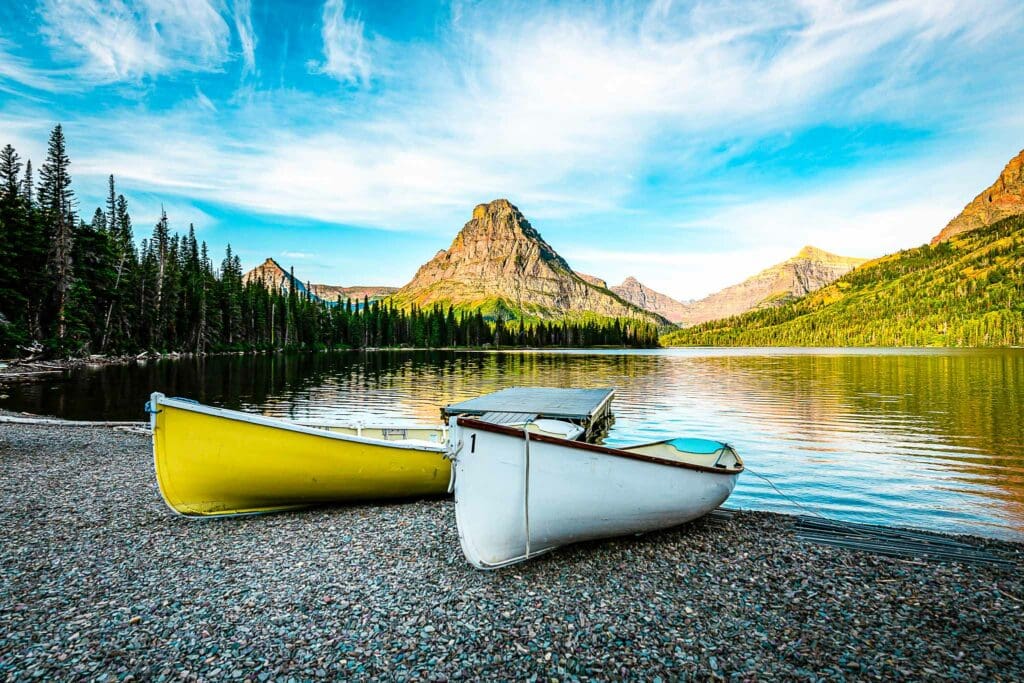
Daybreak over Two Medicine Lake in Glacier National Park.
Glacier National Park has made a small change to the way campsites are reserved this year. ALL SITES from now until July 7th, 2024 can be booked ahead of time on recreation.gov starting at 8 am MST on January 7th. After that date, the park will revert back to its usual system of allowing reservations up to 6 months in advance. To ensure you get the campsite you want, we suggest being logged into your computer and ready to reserve as soon as the booking opens.
Campground Opening Dates:
- Apgar Campground – Opens May 24th (open year-round, but the sites become available starting in the spring season)
- Fish Creek Campground – Opens May 26th
- Many Glacier Campground – Opens June 9th
- St. Mary Campground – Opens May 14th (open year-round, but the sites become available starting in the spring season)
- Two Medicine – Opens June 5th
- Sprague Creek – Opens May 26th
- Avalanche Campground – Opens July 17th
* All opening dates are according to NPS website and subject to change *
Wilderness Camping:
Glacier National Park will implement two early access lotteries for Wilderness Camping advance reservations in 2024 using the Recreation.gov Wilderness Camping Permits online platform. To participate in either lottery, applicants must create a Recreation.gov account.
- Large group lottery (9-12 campers) – Application submission date March 1, 2024
- Standard group lottery (1-8 campers) – Application submission date March 15, 2024
- May 1, 2024, at 8:00 MT and continuing until September 30, 2024, all wilderness campgrounds not reserved during the early access lottery period will become available to the general public on Recreation.gov Wilderness Camping Permits.
The Ten Essentials: How to Equip Yourself for the Backcountry
Main Attractions
While nearly every corner of the park is full of beauty that attracts visitors from both near and far, a few spots within the park are popular amongst nearly all who pay the region a visit. Lake McDonald, the largest lake in the park, has accommodations, bus tours, boat tours, and is surrounded by hiking trails of varying levels of difficulty. The Trail of Cedars is wheelchair accessible and gently winds through the lush forest for about a mile, making it a picturesque glimpse into the surrounding wilderness. Along the Going-to-the-Sun Road, visitors can stop at Logan Pass, located about halfway along the iconic road. Visitor centers and even more accessible to hiking trails, make this high mountain pass a popular destination.

Trail of Cedars at Glacier National Park.
Sunset Cruise on the Picturesque St Marys Lake
The vast and majestic St Marys Lake, the second largest in Glacier National Park, commands breathtaking views of the towering mountains and icy glaciers that loom around it. For a truly immersive experience, take a heart-pounding boat tour on a historic wooden vessel operated by Glacier Park Boat Company from mid-June to mid-September. In just an hour and a half, you’ll be transported through a stunning landscape, with a stop at the awe-inspiring Baring Falls. From there, you can choose to venture further by foot to witness the grandeur of St Mary Falls or Virginia Falls. With tickets priced at $28.75 for adults and $14.50 for children, this adventure promises to be the highlight of your trip.

Experience a thrilling boat tour on a historic wooden vessel with Glacier Park Boat Company, available from mid-June to mid-September. Photo: Glacier Park Boat Company.
Driving on Going-To-The-Sun Road
Stretching 50 miles, the Going-To-The-Sun Road crosses over the Continental Divide at Logan Pass. Along the way, you will encounter stunning glaciers, picturesque valleys, majestic waterfalls, towering peaks, and vibrant wildflowers. And keep your eyes peeled; it’s common for visitors to spot wildlife during their journey on the Sun Road!
Instead of taking your own car across Going-to-the-Sun Road, there are other options available such as the popular Red Bus Tours and the free National Park Service Shuttles.
Due to the mountainous terrain, this highway is only open in certain seasons. Be sure to check the road status before traveling, as dates may vary depending on weather. If some sections are closed, don’t worry – there are many other scenic drives in and around Glacier National Park. With so many features, it can be tough to choose which ones to visit along this engineering marvel. Use the interactive map and guide below to help plan your trip.
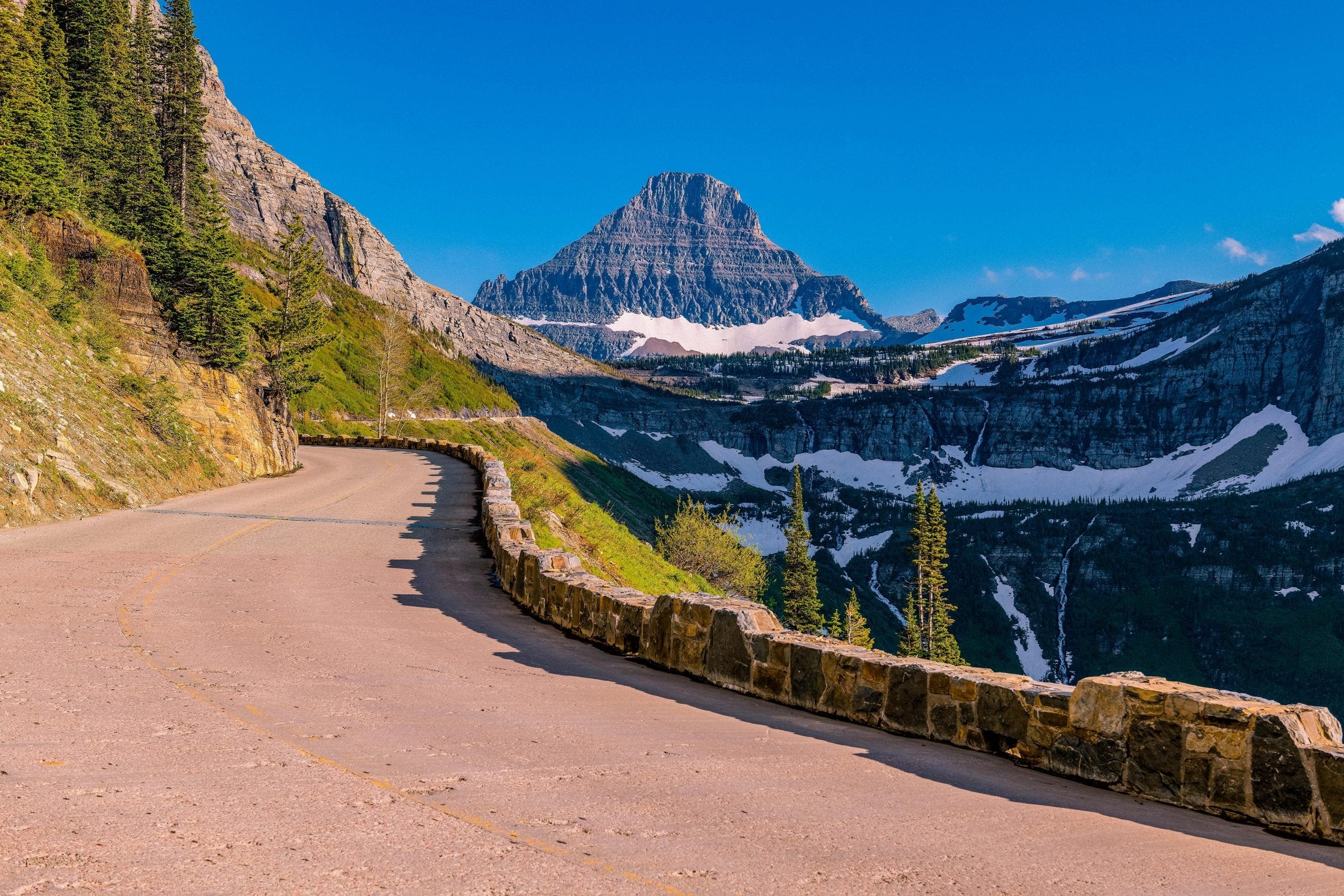
Beautiful view of Glacier National Park along Going-To-The Sun Road
Explorer’s Guide to Going-to-the Sun Road, Glacier National Park, Montana
Hiking:
The most popular activity in the park is by far hiking. There are nearly 700 miles of trails that run throughout Glacier National Park.
While there are numerous well known hikes in the park, one of the most notable is the Continental Divide National Scenic Trail. The trail runs through the park from north to south, spanning 110 miles. A newer trail, known as the Pacific Northwest Scenic Trail, passes through the park for over 50 miles. Traveling east to west, the trail eventually leads to the Puget Sound and out to the Olympic Peninsula.
While the backcountry of the park is sought after for many hikers, it is inaccessible during the winter months. Popular hiking and backpacking trails include Avalanche Lake, Grinnell Glacier Trail, Highline Pass, Piegan Pass, Hidden Lake Trail and Overlook.
For those fortunate enough to experience the breathtaking scenery of Glacier National Park in Montana, here are our top recommended hikes.
Trail of the Cedars: As you enter the Trail of the Cedars, your surroundings transform into a primordial forest of towering ancient western hemlock and red cedar trees. The trail stretches for 0.8 miles (1.3 km) with only a small incline, making it accessible for all hikers. Smoothly paved and wheelchair-friendly, this trail caters to individuals of varying abilities. Along the way, you will come across a bridge that spans over Avalanche Creek, granting views of a picturesque waterfall and gorge. Depending on weather and road conditions, the trail is open from late June to mid-October. Due to its popularity, expect to encounter other hikers during your journey. Take in the vibrant beauty and diverse landscapes of Glacier National Park as you explore the Trail of the Cedars.
Hidden Lake: The Hidden Lake trail is a 5.1 mile (8.2 km) roundtrip hike with an elevation gain of 1,338 feet (408 m). This popular trail is open from late June to mid-October, depending on weather and road conditions. As you make your way from the Logan Pass Visitor Center, you’ll first traverse a paved path and boardwalk through meadows filled with colorful wildflowers and abundant wildlife. After 1.5 miles, you’ll arrive at the Hidden Lake Overlook for breathtaking views. If you wish to continue down to the lake, be prepared for another 1.5 mile descent on a rocky switchback trail. The picturesque lake is perfect for a relaxing picnic while taking in the stunning scenery around you. With its stunning views and varied landscape, the Hidden Lake trail is a top choice for a day hike in Glacier National Park.

Hidden Lake in Glacier National Park, Montana
Highline Trail: Located in Montana, United States, the Highline Trail is a picturesque hiking trail that winds through Glacier National Park. The majority of the trail runs along Garden Wall ridge and the continental divide, offering breathtaking views of the park’s landscape and opportunities to spot glaciers, alpine wildflowers, and wildlife. The hike stretches 7.6 miles (12.2 km) from Logan Pass to Granite Park Chalet, with an additional 11.9 miles (19.2 km) beyond to Fifty Mountain Campground. While the trail is mostly flat and easy, there is one steep switchback up to Haystack Pass that may be challenging for some hikers. Generally open from June to October, the trail’s availability depends on weather conditions and road accessibility.
Due to its popularity, expect to encounter other hikers during your journey. It also features a cliffy section with a hand cable, which may not be suitable for those with a fear of heights. Considered one of the top day hikes in Glacier National Park, the Highline Trail is a must-visit for anyone looking to experience the park’s diverse beauty.
Avalanche Lake Hike: Located in Glacier National Park, Montana, Avalanche Lake is a gorgeous destination for hikers. The round trip trail is 5.9 miles long and has an elevation gain of 757 feet, making it moderately challenging. The hike begins at the accessible Trail of the Cedars, which showcases ancient cedars and hemlocks. As you follow Avalanche Creek, keep an eye out for glimpses of wildlife and blooming wildflowers. Eventually, you will reach the lake, where waterfalls cascade down from the surrounding mountains. This hike is best enjoyed between June and October. Keep in mind that there is a park entrance fee and be cautious of possible bear activity. Due to its popularity, it’s recommended to arrive early or late to avoid crowds and secure parking. For a breathtaking and fulfilling climb in Glacier National Park, consider exploring Avalanche Lake.
Piegan Pass: The Piegan Pass trail stretches 16 miles and offers breathtaking views of the surrounding high peaks and rugged Garden Wall. Beginning at Siyeh Bend Trailhead, the trail winds through lush forests and open meadows before reaching the Siyeh Pass Junction, where hikers can continue to Piegan Pass and take in sweeping vistas of Cataract Mountain, Piegan Mountain, Pollock Mountain, Bishop Cap, and Mount Gould. The descent leads to Many Glacier Hotel parking lot, where shuttle or car arrangements can be made for the return trip. This challenging hike requires a permit for overnight camping in the wilderness and is best enjoyed from June to October when the weather is pleasant and wildflowers are in bloom. Keep an eye out for bighorn sheep and wolverines along the way and remember to respect their habitats. Overall, the Piegan Pass trail is a must-do for adventurous hikers looking to explore the diverse beauty of Glacier National Park.
Grinnell Glacier: Grinnell Glacier is a popular and picturesque hike in Glacier National Park, Montana. The round-trip distance is 11 miles (17.7 km) with an elevation gain of 1,600 feet (487 m) and a peak elevation of 7,000 feet (2,134 m). The difficulty level is moderate to strenuous, so it’s best for those with some fitness and experience. The trail is accessible from mid-June to September and starts at the Many Glacier picnic area. Along the way, you may encounter wildlife such as moose, mountain goats, bighorn sheep, and bears; make sure to carry bear spray and make noise to avoid surprising them.
For those who fear the challenge of 11 miles, a tempting escape awaits – a scenic boat ride by Glacier Park Boat Company across Swiftcurrent Lake and Lake Josephine (operates late June to Mid-September), which cuts the hike down by 3.4 miles to a mere 7.2 miles. Whether you walk or boat, the elevation gain will be about the same. But only true daredevils take on the full journey and reap the ultimate reward at Grinnell Glacier’s icy embrace.

Grinnell Glacier with the frigid, milky blue waters.
Rock Climbing:
The NE ridge of Mt. St. Nicholas is the most classic multi pitch route to a major summit in all of Glacier. The rock quality is far superior to what you usually encounter in Glacier’s alpine. Where’s Jack? is another multi pitch route that follows crack systems and lines of weakness up the southwest face (above Snyder Basin) of the Little Matterhorn.
Rock climbing within the park boundaries isn’t extensive because of the loose rocks that make up the region. However, many people set out to climb the five most rugged peaks within the park and climb all the peaks above 10,000 feet. Nearby climbing spots can be found along Highway 93, known as Point of Rocks, Stryker, and Berne Park.
Fly Fishing:
Besides hiking, Glacier National Park is known for its world-renowned fly fishing. Trout are abundant through the pristine waters of the park. Guided trips often lead visitors to the North and Middle Fork of the Flathead River, and occasionally back into the Bear Mountain Wilderness. Visitors do not need a permit to fish in the park but should note that bull trout are not allowed to be caught.

Fly fishing on the Flathead River in Glacier National Park, Montana.
Whitewater Rafting:
One of our favorite activities is taking the Scenic Float trip down the Middle Fork of the Flathead River, surrounded by pristine mountain landscapes and dense forests. We highly recommend this for anyone looking for a relaxing and educational experience in the park. Our go-to guiding company is Glacier Raft Co, known for their knowledgeable guides who can teach you more about the park. If you’re seeking a bit more excitement, the whitewater section of the Middle Fork offers a fun and beautiful ride. Don’t worry though, the river itself is quite safe and suitable for all levels of experience. Most rafting companies are located near West Glacier along the southern boundary of Glacier Park, so it’s best to plan this activity at the beginning or end of your trip.
Good to Know: Experience Rafting for Free! Reserve a spring getaway of three nights or more at participating lodging locations and get TWO complimentary half day excursions with Glacier Rafting Company!

Rafting the Flathead River in Glacier National Park in Montana.
Canoe/Kayaking:
For lakes stretching up to 10 miles, we highly suggest renting a canoe or kayak and immersing yourself in the beauty of Lake McDonald, St. Mary’s Lake, and/or Two Medicine Lake. Canoes and kayaks are available for rent at both Lake McDonald and Two Medicine Lake.
Horseback Riding:
Why not take advantage of the wild west and hop on a horse to explore the forest from a different angle? Swan Mountain Outfitters offers horseback riding experiences in Glacier Park. Whether you prefer a leisurely ride through the woods or a more daring excursion, Swan Mountain Outfitters has it all.
Bike Riding:
Whether you’re a devoted cyclist or simply enjoy leisurely bike rides, Glacier National Park has something for everyone. One of the most renowned bike routes in the country, the Going-To-The-Sun road, cuts through the heart of the park and shouldn’t be missed by any biking enthusiast. This route is only open from 7am to 11am for cyclists, so plan ahead! If challenging uphill climbs on a bike aren’t your cup of tea, don’t worry – West Glacier and the Camas Road offer beautiful paved paths perfect for a casual ride. And if you need to rent a bike, head to Glacier Outfitters where they have a variety of bikes suited for all experience levels.
Snow Sports:
Because of the rugged peaks of the park, winter activities are far less accessible than summer ones. The lower elevations of the park offer trails for cross country skiing and snowshoeing, along common hiking trails.
Nearby Cities
Kalispell: The closest major city to Glacier National Park is Kalispell. The population is around 93,000, making it the largest city in northwestern Montana. Kalispell is closely located to an abundance of outdoor adventure. Not only is the city near Glacier National Park, but also very close to Flathead National Forest and Hungry Horse Dam. While these places provide an abundance of summer activities, the city is also a hub for both Blacktail Mountain Ski Area and Whitefish Mountain Resort. Local cafes and shops make it the perfect spot to visit after a long day in the mountains.
Whitefish: A mere few miles north lies Whitefish, Montana, a town with a population of 7,750 that resembles a wild west frontier settlement. Here, the locals are a diverse mix of humans and untamed creatures – bears, moose, cutthroat trout, bighorn sheep, eagles, and salmon all roam freely and coexist in an almost eerie harmony. The bustling downtown district draws inspiration from Jackson Hole’s rustic woodgrain aesthetic, but with an added layer of grit and rawness that sets it apart.
Whitefish is renowned for its efforts towards preserving the environment, with a comprehensive network of preserved trails and forests serving to filter the town’s water supply. It is consistently rated as one of the best destinations for skiing in the United States.
This small mountain town has everything you could possibly want and more. The summer nights seem endless, the winter brings heavy snowfall, and the beer is incredibly affordable. It’s a place where you can choose your own path and have plenty of space to do so. See our comprehensive guide for planning the ultimate adventure vacation in Whitefish, Montana.
Conclusion
Glacier National Park is a beautiful and remote wilderness that has no shortage of outdoor activities. The rich history, coupled with the abundance of wildlife make it the perfect destination for exploration. Whether you’re looking for a multi-day backpacking adventure into the deep wilderness, or a scenic ride along the Sun Road, the beauty of the region is sure to leave one coming back for more. As the landscape continues to change, it’s worth taking a trip in the coming years to witness the wild lands of Glacier National Park.
Skyblue Overland Strongly Recommends That You Enroll With Global Rescue Prior To Embarking On Your Next Adventure.
Purchase a Global Rescue membership for your next adventure and travel with peace of mind. Single trip, annual and family options are available.
Learn More!
Popular Articles:
Planning The Perfect Adventure Trip to Whitefish, Montana
Top Adventure Sports Towns: Bozeman, Montana
Shooting the Rushing White Waters In Big Timber Creek
Adventurer’s Guide To Mount Rainier National Park






